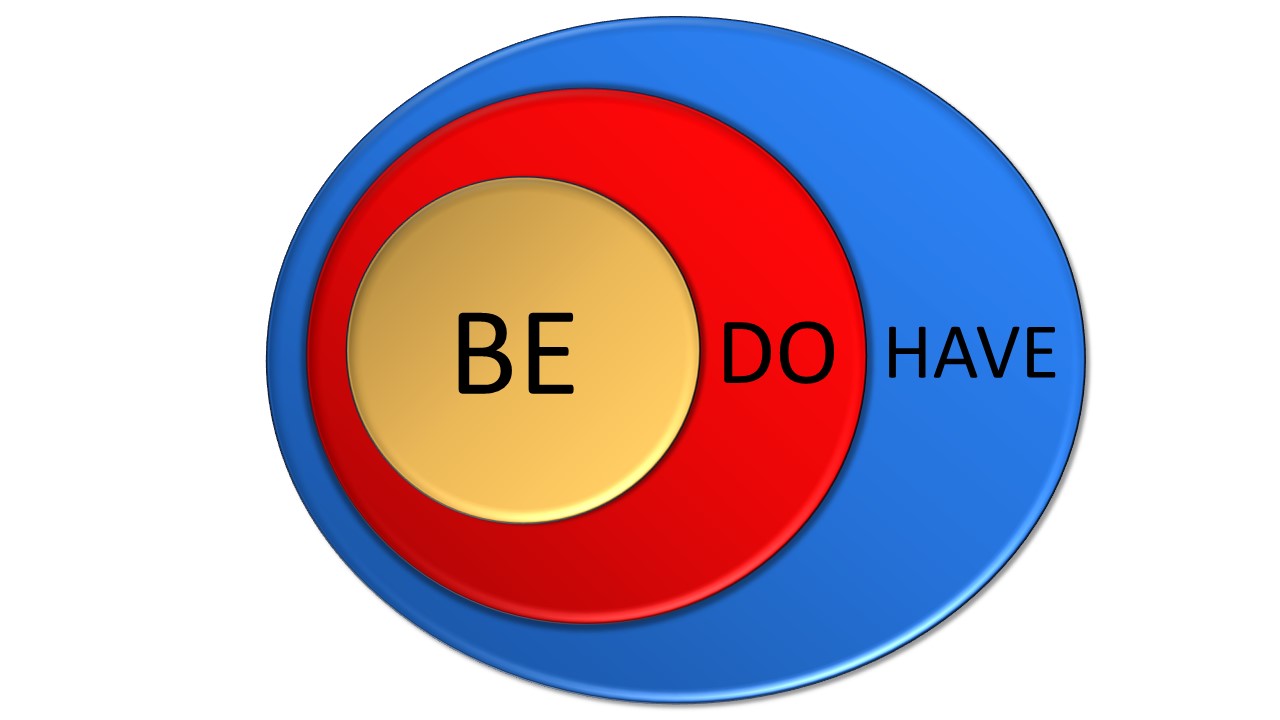The Power of BE
“The ability to be is more important than the ability to do. The ability to do is more important than the ability to have.” — L. Ron Hubbard
Before you can HAVE great success or DO superior work, you need to BE the correct identity. You start by wearing the right hat.
Put on a Better Hat
Let’s say you’re the hiring manager for a big company. You are supposed to find and hire great employees, but you can’t figure it out. You can’t get qualified applicants to apply for the jobs. You’re in trouble with your boss and might be fired if you don’t do your job soon.
Your current BE is, “A bad hiring manager who is confused and desperate.”
So you decide to BE a successful hiring manager. You assume this identity. You wear the right hat.
“I am now a successful hiring manager who finds and hires awesome people.”
You suddenly feel big. You walk around with confidence. You then realize what you are doing wrong. 
“These job ads are horrible!”
One ad states, “To apply, you need two years of training and ten years of experience.” The ad only generates a few applications each week.
You make the job ad more appealing. You include pictures of happy group members and your beautiful city. The ad now states, “If you enjoy exciting challenging work with higher-than average pay, click here to apply!”
Within two days you receive 100 applications. You spot five incredible candidates and soon hire two of them. Your boss is delighted.
Your success began with BE.
Knock Out Your “Opponent”
Now let’s pretend you’re a boxer. You are sitting in one corner of the ring. Your biggest opponent (challenge, problem or barrier) is in the other corner.
Your opponent is seven feet tall and has 250 pounds of hard muscle. You are a normal-size person. What is about to happen?
Maybe you jump up and run at him. You punch him, kick him and spit on him. He just laughs at you until he gets bored and then he knocks you out.
Now let’s say you are a giant. Your body is ten feet tall with 350 pounds of muscle. You jump out of your corner and beat that seven-foot opponent until he falls to the ground. Because you are BEING so large, you have a clear advantage. You blow away the challenges, problems and barriers that have been opposing you.
By increasing or strengthening your BE, you knock out the barriers and win the game.
Let’s look at three more examples using the power of BE.
George Wants a Dream Job
George works at a grocery store, but wants a higher-paying job with computer hardware. He wants to build, install and manage hardware systems for businesses. He needs advanced hardware training and some experience before he can apply for a job he will love. But George just can’t find the time to start, so he stays at the grocery store.
George reads how BE is vital to his success and gives it a try.
He starts to dress like a computer technician. He carries a toolkit on his belt. He strolls around computers with interest and confidence.
Because he is now BEING a hardware professional, he starts doing what confident hardware professionals DO.
He chats with hardware guys. He watches hardware tutorials. He applies for hardware apprenticeships at Intuit, Amazon, Google and others until he is accepted by one. He gains the knowledge and experience he needs.
He then applies for high-paying hardware jobs at great companies. He gets the job of his dreams.
Jane Wants a Healthier Body
Jane wants to jog every day, but she can’t force herself to start. She prefers to stay home in front of screens eating eat junk food.
She decides to simply BE a jogger without going outside. She puts on her running suit, her running shoes and her running hat. She stretches her muscles like a competitive runner. She straps her phone to her arm, puts on her earbuds and turns on some hard rock music.
Because she is BEING a jogger, she can’t wait to get out and jog. She already feels healthier! The DO is easy. She goes outside and enjoys her run.
Andy Wants a Girlfriend
Andy understands what he needs to do: He needs to meet more girls, dress well, have a good sense of humor, go on fun dates and so on. Yet when he tries to do these things his fear takes over. He gets so nervous he can’t talk, or he says stupid things. Most women ignore him.
One night, Andy learns that BE is more important than DO or HAVE. He realizes he is BEING boring, unattractive and shy. So he changes his identity to BEING fun, attractive and confident. A simple mental shift.
The next morning, he puts on his best clothes, carefully shaves, stands straight and adds a smile. He walks around his office BEing a fun, attractive confident guy.
A woman notices him for the first time and smiles at him. He smiles back.
Seven Uses
1. Your plans work. You achieve your objectives faster and more easily. You reach your goals.
For example, “I am an executive who gets my team to do their jobs properly.”
2. You solve old stuck problems by first BEING bigger or smarter than the problems.
For example, “I’m a brilliant film maker who can produce amazing movies without much money.”
3. Your subproduct lists should always start with the appropriate BE.
For example, “I am a brick and tile master.”
4. You make a terrific first impressions with people.
For example, “I’m being a consultant who makes all types of businesses more successful.”
5. You make bigger and more significant contributions to the success of your groups.
For example, “I am a staff trainer who can train anyone how to do any job with speed and high-quality.”
6. You form or upgrade your relationships as you assume a slightly different BE in each relationship.
For example, “I’m a powerful business partner while working with Jim and a great mother to my kids when at home.”
7. You increase your self-control by first BEing someone who easily does what you want to do.
For example, “I am a non-smoker who is not controlled by my body’s urges to smoke.” or “I’m the type of person who is calm and patient in all circumstances.”
Four Sets of Recommendations
Try these four types of recommendations to use the power of BE.
- Change your BE, at will, with these tips.
- Decide what you want to be. Focus on your present time needs.
- Define it. Add details. The more specific details you add the better
- Take off any beingness or hat you are wearing that might be a conflict.
- BE the new identify. Put on the hat. Dive into it. Make it YOU.
- DO. Create your plans. Get busy and do the actions steps you need to take as you wear this hat.
- HAVE. Get the result you want. Achieve the objective. Take and enjoy the reward.
- If you have any problems with these steps, repeat the above steps. Add more details to the BE you want.
- To decide on your best BE, consider other people’s views. Examples:
- Be the parent YOU wish you had when you were a 16-year-old.
- Be the kind of mate or spouse you wish you could have.
- Be the boss you wish you had when you were a worker.
- Be the worker you had if you were a boss.
- Be the type of friend you need.
- Solve old stuck problems, challenges or barriers to your success. Ask yourself questions like these.
- What are you BEing now?
- What might be wrong with that BE?
- What hats are you actually wearing?
- Are they the correct hats for solving the problems?
- What might be a better identity?
- How can you BE a solver, not a problem?
- How can you BE bigger, faster, stronger and smarter than the problem?
- Who will BE the person who finally solves the problem?
- Work out a great plan to accomplish anything. Try these steps.
- Write down something you want to HAVE at the bottom of a blank page.
- In the middle of the page, write down a few of the actions you might need to DO to get it. Leave plenty of room to change and add better steps.
- At the top of the page, work out the identity that you must BE. List the characteristics, attitudes, appearance, qualities and features of this identity. You may already have some of them and only need to add or replace a few.
- Give your identity a name. Examples:
- A powerful executive who turns any company into a big success.
- A professional athlete who wins most events.
- A fantastic schoolteacher who is loved by all children.
- A brilliant marketing consultant who can get new customers for any business.
- A singer-songwriter who writes and records unique, brilliant songs
- Now try out this identity. BE this person. Assume the characteristics. Look at this person in a mirror. Take a walk while BEING this person.
- Once you correctly and completely assume the identity of who you need to BE, you will want to DO the steps you wrote on the paper. You will be motivated to start.
So who should you BE right now?
Three Common Mistakes Regarding BE
Mistake #1: Start with DO or HAVE.
When you start with DO, you can hit a lot of confusion.
“So what are we supposed to do?”
“Is this the best use of my time?”
“Which path should I take?”
Unfortunately, you waste a lot of time and energy trying to work out your best actions.
If you start with HAVE, you just sit there and wait.
“I need ___ before I can do the work”
“My life will be perfect once I have ___.
“If I first get a ___, I can reach my goals.”
Unfortunately, the thing you need to HAVE never arrives.
The solution is to find the correct BE and put on the right hat, then figure out what to DO. When you then DO those things, you get what you want to HAVE.
Mistake #2: Refusing to Change Your BE
Some people will only assume one identity or only wear one hat. They fail to get the things they want to DO or HAVE because they refuse to BE anything else.
For example, Stephen wants a highly-successful accounting firm, but he won’t change his BE. “I don’t care what anyone thinks. My accounting work is perfect and I shouldn’t have to change who I am.”
So Stephen wears the same type of clothing he wore in high school. He uses immature language. He eats tons of junk food. He plays video games whenever possible. He is BEING a teenager. He never succeeds like Marie.
Marie also wants a highly-successful accounting firm. She starts with BE. Normally she is a mom and a wife, but she changes her BE. She takes on the identity of a highly-successful accountant.
Even though she works from home, she wears professional clothing every day. She uses perfect English and keeps her office spotless. She learns to conduct video calls with a professional camera, background, camera angle and lighting.
Her clients are always impressed with her and her work. They follow her advice. They recommend her services to others.
Marie is BEing a professional.
Mistake #3: Confusing Ego with BE
Ego Is an Enemy
Having a big ego is not the same as assuming a big beingness. Being egotistical leads to failure, ruined lives and disaster. A big self-centered ego is not your friend.
Fifteen signs of a big ego.
- Obsessed with their self-importance.
- Overestimates their skills and intelligence.
- Make people wrong to prove they are right.
- Argumentative; difficult to work or live with.
- Craves fame, respect, rank, admiration and power.
- Ignores the needs of others, even by those who help them.
- Jealous of those who are smarter, more successful or more powerful.
- They are know-it-alls; not open to learning. They learn nothing from their mistakes.
- Dominates conversations; ignores other opinions.
- Believes they deserve more than they earn; they are “entitled.”
- Blames others for their failures.
- Easily hurts others to protect their image or to reach their goals.
- Cannot accept nor admit their flaws.
- Being “right” is more important than being correct.
- The world revolves around them.
BE Is a Friend
The correct BE leads to success. People with big BEs are your friends. A-Performer winners, or Big Beings, do not have big egos. They have correct beingnesses.
Fifteen signs of a correct BE.
- Does not care about being important, liked, admired or respected.
- Constantly finds ways to improve.
- Actions are usually correct and carried out with energy and confidence.
- Willing to be whatever is best for their groups, from the top leader position to a new worker position.
- Can easily settle for less without stress; limits are not important.
- Considers failure just a way to learn; as an important step to success.
- Willing to delay or even skip the rewards.
- Happy to change their minds when they learn new facts.
- Interested in everyone’s opinions.
- Operates in present time; not stuck in past wins or losses.
- Flexible.
- Enjoys creating new things.
- Shares the glory with everyone involved.
- Prefers to be correct rather than being “right.”
- Willing and able to help groups and mankind.
